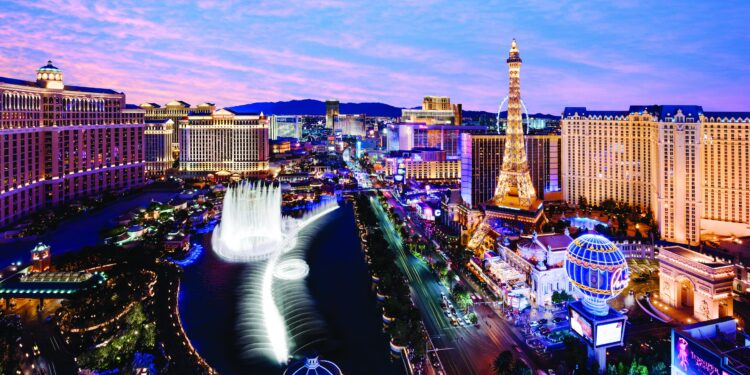Las Vegas, long heralded as America’s premier entertainment destination, is facing a troubling decline in tourism-a trend that experts warn could signal broader challenges for the U.S. economy. According to a recent report by Fodor’s Travel Guide, the city’s sinking visitor numbers underscore potential vulnerabilities in consumer confidence and spending patterns, raising concerns about the health of the nation’s travel and hospitality sectors. As Las Vegas grapples with reduced foot traffic and dwindling hotel occupancy rates, economists and industry analysts alike are watching closely to gauge what this downturn might mean for economic recovery efforts across the country.
Las Vegas Tourism Decline Signals Broader Economic Challenges in the US
Recent statistics reveal a sharp downturn in Las Vegas tourism, with hotel occupancy rates dropping nearly 15% year-over-year during peak travel months. This decline, often a barometer for consumer confidence, highlights deeper fissures within the broader U.S. economy. Analysts point to rising inflation, higher borrowing costs, and shifting travel habits as key factors discouraging visitors from both domestic and international markets. The repercussions extend beyond hotel revenues, affecting local entertainment venues, restaurants, and retail sectors that heavily rely on steady tourist inflows.
Economic indicators tied to the travel industry depict a ripple effect that could foreshadow a larger slowdown. Below is a summary of key metrics comparing Las Vegas tourism performance between 2023 and 2024:
| Metric | 2023 | 2024 | Change |
|---|---|---|---|
| Average Daily Hotel Rates | $150 | $140 | -6.7% |
| Visitor Arrivals (Millions) | 42.5 | 36.1 | -15.1% |
| Casino Revenue (Billion $) | 7.8 | 7.2 | -7.7% |
The erosion in these core areas underscores a warning sign not just for Vegas but for the U.S. economy at large. As travelers tighten budgets and delay discretionary spending, local economies centered on tourism face increasing strain. Economic experts advise close monitoring of travel trends as early indicators for managing national economic policies and forecasting recovery strategies.
Analyzing the Impact on Hospitality, Entertainment, and Local Employment
The downward trend in Las Vegas tourism is sending ripples far beyond the Strip, significantly affecting the hospitality and entertainment sectors. Hotels and casinos, once bustling hubs of activity, are now grappling with decreased occupancy rates and shrinking revenues. This contraction pressures service staff, performers, and event organizers who rely heavily on a steady influx of visitors. Jobs that were once deemed secure are becoming vulnerable, with many establishments resorting to reduced shifts, layoffs, or even closures of key entertainment venues. The local economy, known for its vibrant nightlife and luxury experiences, faces an uncertain future as discretionary spending tightens among potential tourists.
Key challenges facing affected industries include:
- Reduction in demand for live shows and conventions
- Decline in hotel cash flows impacting maintenance and upgrades
- Rising unemployment among hospitality workers and entertainers
- Lower tax revenues affecting city-funded services and infrastructure
| Industry Segment | Estimated Job Loss (%) | Revenue Decline (Q1 2024) |
|---|---|---|
| Hotels & Resorts | 12% | 15% |
| Entertainment & Shows | 18% | 22% |
| Restaurants & Bars | 10% | 13% |
| Event & Convention Services | 20% | 25% |
Strategies for Revitalizing Tourism and Stimulating Economic Recovery
The downturn in Las Vegas’ tourism sector has raised alarms, but targeted strategies could reverse this trend and spark broader economic recovery. By focusing on diversifying entertainment offerings beyond traditional gambling, the city can attract a more varied visitor demographic. Investing in cultural festivals, eco-tourism, and family-friendly attractions offers the potential to boost visitor numbers year-round. Additionally, enhancing infrastructure such as public transportation and airport facilities will improve accessibility, encouraging longer stays and higher expenditure per visitor.
Local businesses and government agencies are urged to collaborate on initiatives that encourage sustainable tourism growth. Key actions include:
- Incentivizing off-peak travel through discounted rates and special packages to smooth out visitor flow and maximize hotel occupancy.
- Promoting regional travel partnerships to create multi-city itineraries linking Las Vegas with nearby destinations.
- Implementing technology-driven marketing campaigns targeting emerging markets via social media and personalized offers.
| Strategy | Potential Impact | Timeline |
|---|---|---|
| Diversified Attractions | Broadened visitor base by 15% | 6-12 months |
| Off-Peak Incentives | Improved hotel occupancy by 10% | 3-6 months |
| Regional Partnerships | Extended visitor stay duration by 1 day | 12 months+ |
| Tech-Driven Marketing | Increased engagement by 25% | Ongoing |
Closing Remarks
As Las Vegas grapples with declining visitor numbers, the ripple effects extend far beyond the Strip, signaling potential vulnerabilities in the broader U.S. economy. Traditionally a bellwether for consumer confidence and discretionary spending, the city’s struggling tourism sector underscores deeper economic uncertainties that policymakers and industry leaders must address. Monitoring Las Vegas’ recovery-or continued downturn-will be crucial in gauging the overall health of domestic travel and economic momentum in the months ahead.































